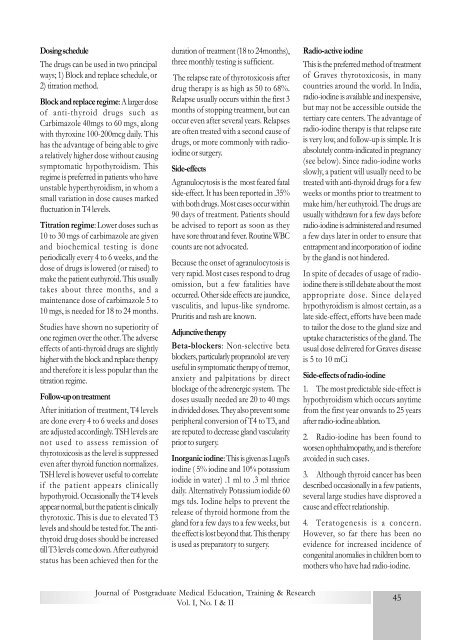Journal 1pages FINAL 34- - National Board Of Examination
Journal 1pages FINAL 34- - National Board Of Examination
Journal 1pages FINAL 34- - National Board Of Examination
You also want an ePaper? Increase the reach of your titles
YUMPU automatically turns print PDFs into web optimized ePapers that Google loves.
Dosing scheduleThe drugs can be used in two principalways; 1) Block and replace schedule, or2) titration method.Block and replace regime: A larger doseof anti-thyroid drugs such asCarbimazole 40mgs to 60 mgs, alongwith thyroxine 100-200mcg daily. Thishas the advantage of being able to givea relatively higher dose without causingsymptomatic hypothyroidism. Thisregime is preferred in patients who haveunstable hyperthyroidism, in whom asmall variation in dose causes markedfluctuation in T4 levels.Titration regime: Lower doses such as10 to 30 mgs of carbimazole are givenand biochemical testing is doneperiodically every 4 to 6 weeks, and thedose of drugs is lowered (or raised) tomake the patient euthyroid. This usuallytakes about three months, and amaintenance dose of carbimazole 5 to10 mgs, is needed for 18 to 24 months.Studies have shown no superiority ofone regimen over the other. The adverseeffects of anti-thyroid drugs are slightlyhigher with the block and replace therapyand therefore it is less popular than thetitration regime.Follow-up on treatmentAfter initiation of treatment, T4 levelsare done every 4 to 6 weeks and dosesare adjusted accordingly. TSH levels arenot used to assess remission ofthyrotoxicosis as the level is suppressedeven after thyroid function normalizes.TSH level is however useful to correlateif the patient appears clinicallyhypothyroid. Occasionally the T4 levelsappear normal, but the patient is clinicallythyrotoxic. This is due to elevated T3levels and should be tested for. The antithyroiddrug doses should be increasedtill T3 levels come down. After euthyroidstatus has been achieved then for theduration of treatment (18 to 24months),three monthly testing is sufficient.The relapse rate of thyrotoxicosis afterdrug therapy is as high as 50 to 68%.Relapse usually occurs within the first 3months of stopping treatment, but canoccur even after several years. Relapsesare often treated with a second cause ofdrugs, or more commonly with radioiodineor surgery.Side-effectsAgranulocytosis is the most feared fatalside-effect. It has been reported in .35%with both drugs. Most cases occur within90 days of treatment. Patients shouldbe advised to report as soon as theyhave sore throat and fever. Routine WBCcounts are not advocated.Because the onset of agranulocytosis isvery rapid. Most cases respond to drugomission, but a few fatalities haveoccurred. Other side effects are jaundice,vasculitis, and lupus-like syndrome.Pruritis and rash are known.Adjunctive therapyBeta-blockers: Non-selective betablockers, particularly propranolol are veryuseful in symptomatic therapy of tremor,anxiety and palpitations by directblockage of the adrenergic system. Thedoses usually needed are 20 to 40 mgsin divided doses. They also prevent someperipheral conversion of T4 to T3, andare reputed to decrease gland vascularityprior to surgery.Inorganic iodine: This is given as Lugol’siodine ( 5% iodine and 10% potassiumiodide in water) .1 ml to .3 ml thricedaily. Alternatively Potassium iodide 60mgs tds. Iodine helps to prevent therelease of thyroid hormone from thegland for a few days to a few weeks, butthe effect is lost beyond that. This therapyis used as preparatory to surgery.Radio-active iodineThis is the preferred method of treatmentof Graves thyrotoxicosis, in manycountries around the world. In India,radio-iodine is available and inexpensive,but may not be accessible outside thetertiary care centers. The advantage ofradio-iodine therapy is that relapse rateis very low, and follow-up is simple. It isabsolutely contra-indicated in pregnancy(see below). Since radio-iodine worksslowly, a patient will usually need to betreated with anti-thyroid drugs for a fewweeks or months prior to treatment tomake him/her euthyroid. The drugs areusually withdrawn for a few days beforeradio-iodine is administered and resumeda few days later in order to ensure thatentrapment and incorporation of iodineby the gland is not hindered.In spite of decades of usage of radioiodinethere is still debate about the mostappropriate dose. Since delayedhypothyroidism is almost certain, as alate side-effect, efforts have been madeto tailor the dose to the gland size anduptake characteristics of the gland. Theusual dose delivered for Graves diseaseis 5 to 10 mCiSide-effects of radio-iodine1. The most predictable side-effect ishypothyroidism which occurs anytimefrom the first year onwards to 25 yearsafter radio-iodine ablation.2. Radio-iodine has been found toworsen ophthalmopathy, and is thereforeavoided in such cases.3. Although thyroid cancer has beendescribed occasionally in a few patients,several large studies have disproved acause and effect relationship.4. Teratogenesis is a concern.However, so far there has been noevidence for increased incidence ofcongenital anomalies in children born tomothers who have had radio-iodine.<strong>Journal</strong> of Postgraduate Medical Education, Training & ResearchVol. I, No. I & II45
















